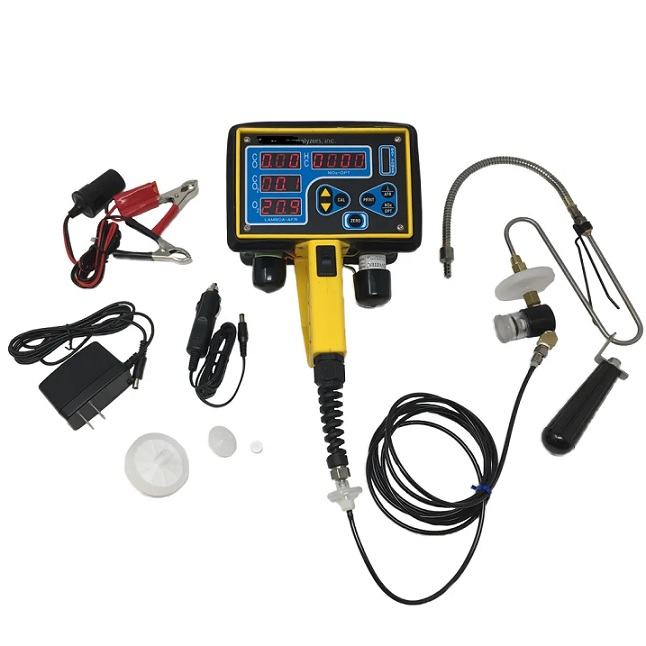In our rapidly advancing world, monitoring and managing carbon dioxide (CO2) levels have become paramount for various industries and environmental applications. CO2 gas analyzers play a crucial role in this endeavor, providing valuable insights into the concentration of this greenhouse gas. In this comprehensive overview, we will delve into the workings of CO2 gas analyzer, exploring their principles, technologies, applications, and the significance they hold in today’s environmental landscape.
Understanding the Basics
- Introduction to CO2 Gas Analyzers
CO2 gas analyzers are sophisticated instruments designed to indicate the concentration of carbon dioxide in a given environment. Whether in industrial processes, environmental monitoring, or research applications, these analyzers provide critical data for understanding and managing CO2 levels.
- Principles of Operation
The fundamental principle behind CO2 gas analyzers is based on the absorption of infrared light by CO2 molecules. Infrared gas analyzers (IRGA) are commonly used for this purpose. When infrared light croses through a sample gas containing CO2, the gas absorbs specific wavelengths of light, and the remaining light is detected by a sensor. The amount of absorbed light corresponds to the CO2 concentration.
Types of CO2 Gas Analyzers
- Non-Dispersive Infrared (NDIR) Analyzers
NDIR analyzers are the most prevalent type of CO2 gas analyzers. They operate on the principle of measuring the amount of infrared light absorbed by CO2 molecules. The analyzer emits infrared light through a sample gas, and the amount of absorbed light is proportional to the CO2 concentration. NDIR analyzers are known for their accuracy and stability, making them suitable for various applications.
- Chemical Absorption Analyzers
Another type of CO2 gas analyzer utilizes chemical absorption methods. In this approach, a chemical solution reacts with CO2 in the sample gas, producing a measurable change in properties. This change is then quantified to determine the CO2 concentration. While less common than NDIR analyzers, chemical absorption analyzers offer specific advantages in certain applications.
Advanced Technologies in CO2 Gas Analyzers
- Tunable Diode Laser Absorption Spectroscopy (TDLAS)
TDLAS represents a cutting-edge technology in CO2 gas analysis. It employs a tunable diode laser to measure the absorption of specific wavelengths by CO2 molecules. TDLAS provides high sensitivity, allowing for precise and rapid measurements. This technology is particularly advantageous in applications requiring real-time monitoring and control.
- Cavity Ring-Down Spectroscopy (CRDS)
CRDS is a highly sensitive technique used in some advanced CO2 gas analyzers. It measures the time it takes for light to decay in an optical cavity filled with the sample gas. This decay time is inversely proportional to the CO2 concentration. CRDS offers exceptional precision and is suitable for trace gas analysis.
Applications of CO2 Gas Analyzers
- Environmental Monitoring
CO2 gas analyzers play a vital role in environmental monitoring, helping scientists and researchers assess carbon dioxide levels in the atmosphere. This information is crucial for understanding climate change, tracking emissions, and formulating effective environmental policies.
- Industrial Processes
In industrial settings, CO2 gas analyzers are employed to monitor and control processes that produce or consume CO2. From manufacturing to chemical production, these analyzers contribute to optimizing operations, ensuring compliance with environmental regulations, and enhancing overall efficiency.
- Greenhouse Gas Emission Monitoring
Monitoring greenhouse gas emissions is a critical aspect of addressing climate change. CO2 gas analyzers are instrumental in quantifying emissions from various sources, including power plants, factories and transportation. Accurate measurement data is essential for implementing emission reduction strategies.
- Medical Applications
In the medical field, CO2 gas analyzers are used in respiratory monitoring. Capnography, a technique that measures the concentration of CO2 in exhaled breath, is essential in anesthesia, intensive care, and emergency medicine.
Significance in Climate Change Mitigation
- Role in Climate Research
CO2 gas analyzers contribute significantly to climate research by providing accurate data on atmospheric CO2 levels. This information is indispensable for understanding the impact of human activities on the climate and developing strategies to mitigate the effects of climate change.
- Supporting Sustainable Practices
By enabling precise monitoring of CO2 emissions, gas analyzers empower industries to adopt sustainable practices. Identifying sources of emissions and implementing measures to reduce them are vital steps in the global effort to combat climate change.
Challenges and Future Developments
- Challenges in CO2 Gas Analysis
Despite their advancements, CO2 gas analyzers face challenges such as interference from other gases, calibration requirements, and the need for regular maintenance. Overcoming these challenges is crucial to ensuring the reliability and accuracy of measurement data.
- Emerging Trends and Innovations
Ongoing research and development in the field of CO2 gas analysis are driving innovations. Miniaturization of analyzers, integration with IoT technologies for remote monitoring, and the development of low-cost sensors are some of the trends shaping the future of CO2 gas analyzers.
Conclusion
In conclusion, CO2 gas analyzers are indispensable tools in our quest to monitor and manage carbon dioxide levels. From their fundamental principles to advanced technologies, these analyzers contribute to a wide range of applications, from environmental monitoring to industrial processes and medical settings. As we continue to face the challenges of climate change, the role of CO2 gas analyzers becomes increasingly crucial in supporting sustainable practices and mitigating the impact of human activities on the environment.

